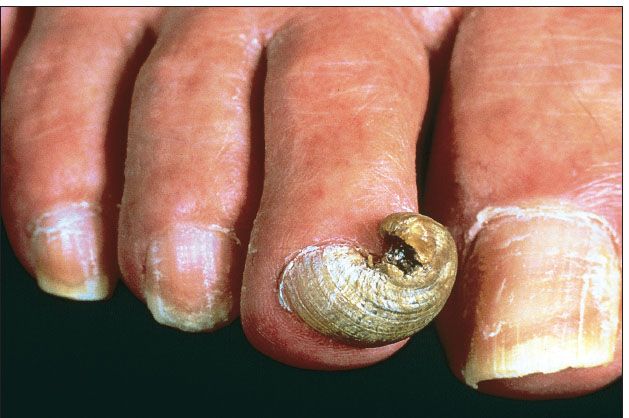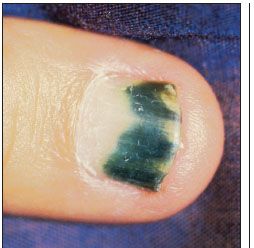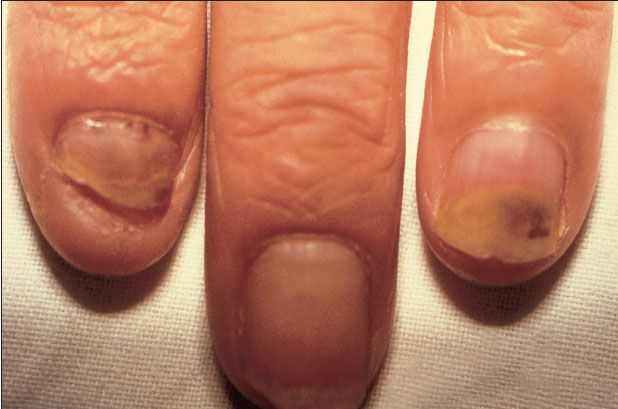A Collage of Nail Lesions
Nail lesions shown here: Onychogryphosis, pseudomonal infection, myxoid cyst, onycholisis.

Onychogryphosis
This “ram’s horn” toenail had been bizarrely curved for many years, according to a 65-year-old man. The accentuated curve in the thickened nail develops as one side of the nail grows faster than the other. Onychogryphosis most frequently occurs on the great toenail, less often on the other toenails; fingernails are rarely involved. The most common precipitating factor is injury to the nail matrix. Poorly fitting footwear, hallux valgus, onychomycosis, psoriasis, ichthyosis, diseases of the central and peripheral nervous systems, vascular disease, and even old age have all been associated with this problem; however, the cause is often not obvious.
Treatment ranges from conservative therapy, such as filing the nail or using concentrated urea paste, to more radical steps, such as nail removal and matrixectomy.
(Case and photograph courtesy of Dr David I. Wolf.)

Pseudomonal Infection
Green pigmentation appeared in the thumbnail of a nursery school worker whose hands were constantly in water. The discoloration resulted from a pseudomonal infection. The woman was advised to soak her thumb in acetic acid solution and limit immersion in water; these measures cleared the infection.
(Case and photograph courtesy of Dr William Keenan.)

Grooved Nail From Synovial Cyst
This synovial (myxoid) cyst lies close to the proximal nail fold. Such cysts exert downward pressure on the nail-producing cells, which results in a grooved nail. Treatment measures include deep excision; evacuation by puncturing, then replacing the gelatinous fluid with triamcinolone; and injection of triamcinolone around the cyst rather than into it. Success has been reported with each type of treatment, but recurrences are common.
(Case and photograph courtesy of Dr Joseph P. Bark.)
Onycholysis
A 32-year-old teacher presented with a 6-month history of palpitations, weight loss, and heat intolerance. For the past 3 months, he had also noticed that his fingernails were separating from their beds and turning white at their distal border. The condition was diagnosed as thyrotoxicosis, a common cause of onycholysis. The nail plate’s separation from the terminal epidermal nail bed is evidenced by its change in light reflection; hence, the opaque, whitish color.
Other conditions that may cause onycholysis include porphyria, trauma, candidal or dermatophytic infestation, dermatological disease (eg, psoriasis or lichen planus), and the use of cytotoxic drugs.
(Case and photograph courtesy of Dr K. K. Pun.)
